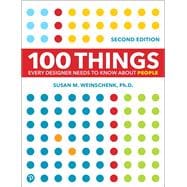Apply psychology and behavioral science to web, UX, and graphic design
Behavioral science leader and CEO at The Team W, Inc., Susan M. Weinschenk, provides a guide that every designer needs, combining real science and research with practical examples on everything from font size to online interactions. With this book you'll design more intuitive and engaging apps, software, websites and products that match the way people think, decide and behave.
Here are some of the questions this book will answer:
- What grabs and holds attention?
- What makes memories stick?
- What motivates people?
- How does listening to music make people feel?
- How do you engineer a decision?
- What line length for text is best?
- Are some fonts better than others?
We design to elicit responses from people. We want them to buy something, read more, or take action of some kind. Designing without understanding what makes people act the way they do is like exploring a new city without a map: results will be haphazard, confusing, and inefficient. Increase the effectiveness of your designs by using science-backed examples on human behavior.
"Every once in a while, a book comes along that is so well-written, researched, and designed that I just can't put it down. That's how good 100 Things Every Designer Needs to Know About People is!"
—Lynne Cooke, Clinical Assistant Professor at Arizona State University









